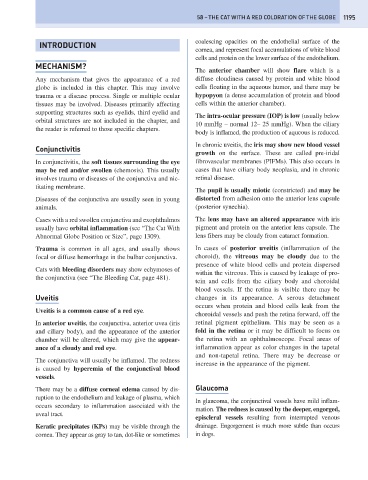Page 1203 - Problem-Based Feline Medicine
P. 1203
58 – THE CAT WITH A RED COLORATION OF THE GLOBE 1195
coalescing opacities on the endothelial surface of the
INTRODUCTION
cornea, and represent focal accumulations of white blood
cells and protein on the lower surface of the endothelium.
MECHANISM?
The anterior chamber will show flare which is a
Any mechanism that gives the appearance of a red diffuse cloudiness caused by protein and white blood
globe is included in this chapter. This may involve cells floating in the aqueous humor, and there may be
trauma or a disease process. Single or multiple ocular hypopyon (a dense accumulation of protein and blood
tissues may be involved. Diseases primarily affecting cells within the anterior chamber).
supporting structures such as eyelids, third eyelid and
The intra-ocular pressure (IOP) is low (usually below
orbital structures are not included in the chapter, and
10 mmHg – normal 12– 25 mmHg). When the ciliary
the reader is referred to those specific chapters.
body is inflamed, the production of aqueous is reduced.
In chronic uveitis, the iris may show new blood vessel
Conjunctivitis
growth on the surface. These are called pre-iridal
In conjunctivitis, the soft tissues surrounding the eye fibrovascular membranes (PIFMs). This also occurs in
may be red and/or swollen (chemosis). This usually cases that have ciliary body neoplasia, and in chronic
involves trauma or diseases of the conjunctiva and nic- retinal disease.
titating membrane.
The pupil is usually miotic (constricted) and may be
Diseases of the conjunctiva are usually seen in young distorted from adhesion onto the anterior lens capsule
animals. (posterior synechia).
Cases with a red swollen conjunctiva and exophthalmos The lens may have an altered appearance with iris
usually have orbital inflammation (see “The Cat With pigment and protein on the anterior lens capsule. The
Abnormal Globe Position or Size”, page 1309). lens fibers may be cloudy from cataract formation.
Trauma is common in all ages, and usually shows In cases of posterior uveitis (inflammation of the
focal or diffuse hemorrhage in the bulbar conjunctiva. choroid), the vitreous may be cloudy due to the
presence of white blood cells and protein dispersed
Cats with bleeding disorders may show echymoses of
within the vitreous. This is caused by leakage of pro-
the conjunctiva (see “The Bleeding Cat, page 481).
tein and cells from the ciliary body and choroidal
blood vessels. If the retina is visible there may be
Uveitis changes in its appearance. A serous detachment
occurs when protein and blood cells leak from the
Uveitis is a common cause of a red eye.
choroidal vessels and push the retina forward, off the
In anterior uveitis, the conjunctiva, anterior uvea (iris retinal pigment epithelium. This may be seen as a
and ciliary body), and the appearance of the anterior fold in the retina or it may be difficult to focus on
chamber will be altered, which may give the appear- the retina with an ophthalmoscope. Focal areas of
ance of a cloudy and red eye. inflammation appear as color changes in the tapetal
and non-tapetal retina. There may be decrease or
The conjunctiva will usually be inflamed. The redness
increase in the appearance of the pigment.
is caused by hyperemia of the conjunctival blood
vessels.
There may be a diffuse corneal edema caused by dis- Glaucoma
ruption to the endothelium and leakage of plasma, which
In glaucoma, the conjunctival vessels have mild inflam-
occurs secondary to inflammation associated with the
mation. The redness is caused by the deeper, engorged,
uveal tract.
episcleral vessels resulting from interrupted venous
Keratic precipitates (KPs) may be visible through the drainage. Engorgement is much more subtle than occurs
cornea. They appear as gray to tan, dot-like or sometimes in dogs.

